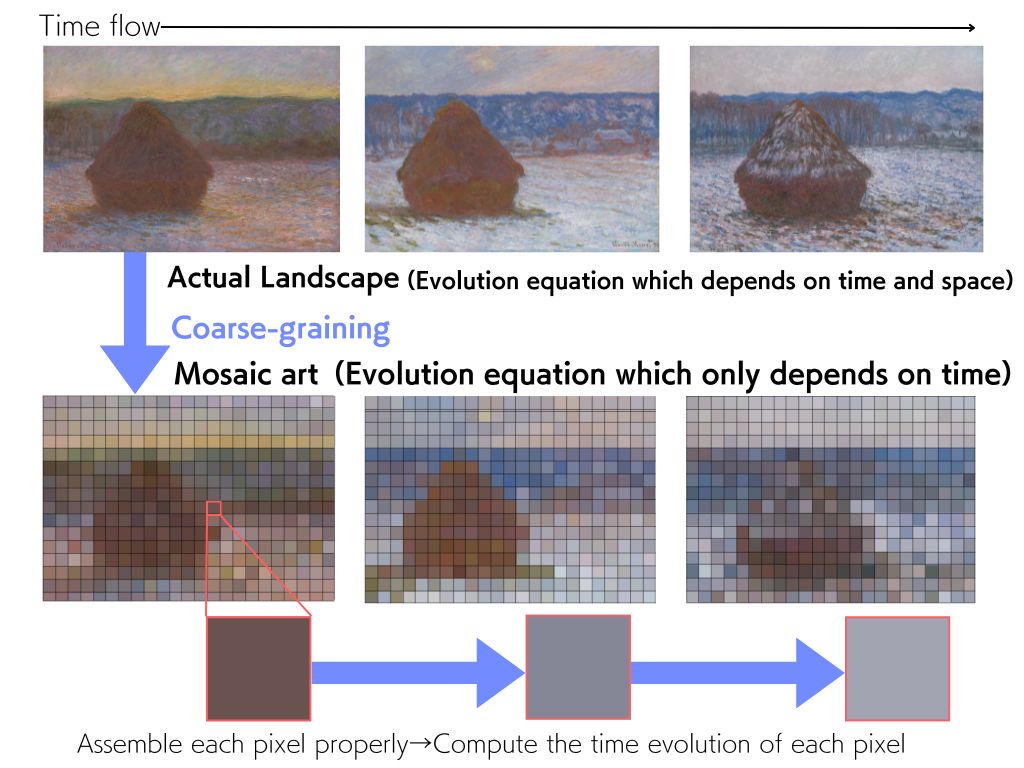Executive Summary
Question
A detection of primordial gravitational waves, ripples of spacetime generated in the early universe, is believed to lead to the elucidation of the physical laws of the extremely high-energy universe shortly after the beginning of the universe. However, theoretical calculations of primordial gravitational waves are often very complicated, posing a barrier to understanding models of the early universe.
Findings
By applying the separate universe approach, which interprets the universe like mosaic art, we have significantly simplified the calculation of primordial gravitational waves. This allows the prediction of gravitational waves through a back-of-envelop calculation, even for models that previously required complex numerical computations.
Meaning
This development enables the calculation of theoretical predictions for a variety of models, including those that were previously difficult to analyze, and is expected to contribute to the understanding of the early universe through gravitational wave observations. Additionally, this method has been shown to be useful for intuitively understanding the dynamics of primordial gravitational waves.
Overview
It has been widely believed that there was an epoch of rapid accelerated expansion caused by extremely high vacuum energy, which is called cosmic inflation. The inflation scenario has been tested by measuring the density fluctuations in the early universe, called the primordial density perturbation, via various cosmological observations. However, the driving force of this rapid acceleration and the evolution of other matters in this accelerating universe still remain unknown. Numerous theories (or models of inflation) have been proposed to explain the accelerating universe. It is possible to verify which model is correct by comparing the theoretical prediction of each inflation model with the latest observations.
During the inflationary period, primordial gravitational waves, which are ripples of spacetime, were generated through quantum effects similar to the primordial density fluctuation. It is believed that primordial gravitational waves contain crucial information about the models of inflation such as the magnitude of the vacuum energy that caused inflation. However, theoretical calculations which estimate primordial gravitational waves for each model are generally very complicated, posing a barrier to identifying the correct inflation model. Particularly, small effects known as nonlinear effects are important for distinguishing between different models, but calculating the nonlinear effects of primordial gravitational waves often requires computer-based calculations, limiting theoretical research on primordial gravitational waves to a few simplistic models.
In contrast to gravitational waves, the theoretical research on primordial density fluctuation is more advanced. A simple calculation method known as the separate universe approach, which interprets the inhomogeneous spatial distribution of the universe like a mosaic art, was established in the 1990s and has been widely used ever since. This method significantly simplifies calculations by describing the evolution of the universe, which depends on time and space, using evolution equations that depend only on time. However, there was no calculation method using the separate universe approach for gravitational waves.
In this study, we have opened the door that had been closed for over a quarter of a century since the establishment of this simple calculation method for the density fluctuation and, for the first time, established a calculation method for primordial gravitational waves using the separate universe approach. This makes it possible to study a wide range of inflation models without relying on complex numerical calculations. Since the separate universe approach also helps in intuitively understanding the evolution of the universe, it is expected to deepen our understanding of the time evolution of primordial gravitational waves.
Primordial gravitational waves can be detected by examining the polarization of light coming from all directions in the universe, known as cosmic microwave background radiation. Due to their significance, many observation plans have been proposed. By using the newly developed separate universe approach, it would be now possible to calculate primordial gravitational waves predicted by a variety of cosmological models, including those that were previously difficult to analyze. This is expected to reveal the overall picture of the universe shortly after the beginning through the detection of gravitational waves and ultimately lead to the elucidation of the physical laws of the extreme-high-energy world, which cannot be tested by accelerator experiments.
Figure: This figure provides a naive image of the separate universe approach. Since the actual universe varies from place to place, we need to solve an evolution equation which depends both time and space position. By using the separate universe approach, the evolution of the coarse-grained universe can be computed simply by solving a time-dependent equation for each monochromatic pixel individually.

Research group
This project was conducted by Takahiro Tanaka, a professor from the Graduate School of Science, Kyoto University and Yuko Urakawa, an associate professor from the High Energy Accelerator Research Organization (KEK) and the Kobayashi-Maskawa Institute for the Origin of Particles and the Universe, Nagoya University.
Acknowledgement
This project was supported by Grant-in-Aid for Scientific Research (A), (C), (B) under Contract Nos. JP23H00110 (T.T.), JP20K03928 (T.T), JP19H01894 (Y.U.), and JP23H01177 (Y.U.), Fostering Joint International Research (B) under Contract No.~21KK0050 (Y.U.), and JST FOREST Program under Contract No.~JPMJFR222Y (Y.U.).
Published paper
Title:Statistical anisotropy of primordial gravitational waves from generalized δN formalism
Authors:Takahiro Tanaka and Yuko Urakawa
Journal: Physical Review Letters
https://journals.aps.org/prl/accepted/40074Y5fX0717e8843896887ae36d161c44066b3d
Contact
High Energy Accelerator Research Organization (KEK)
E-mail:press@kek.jp
